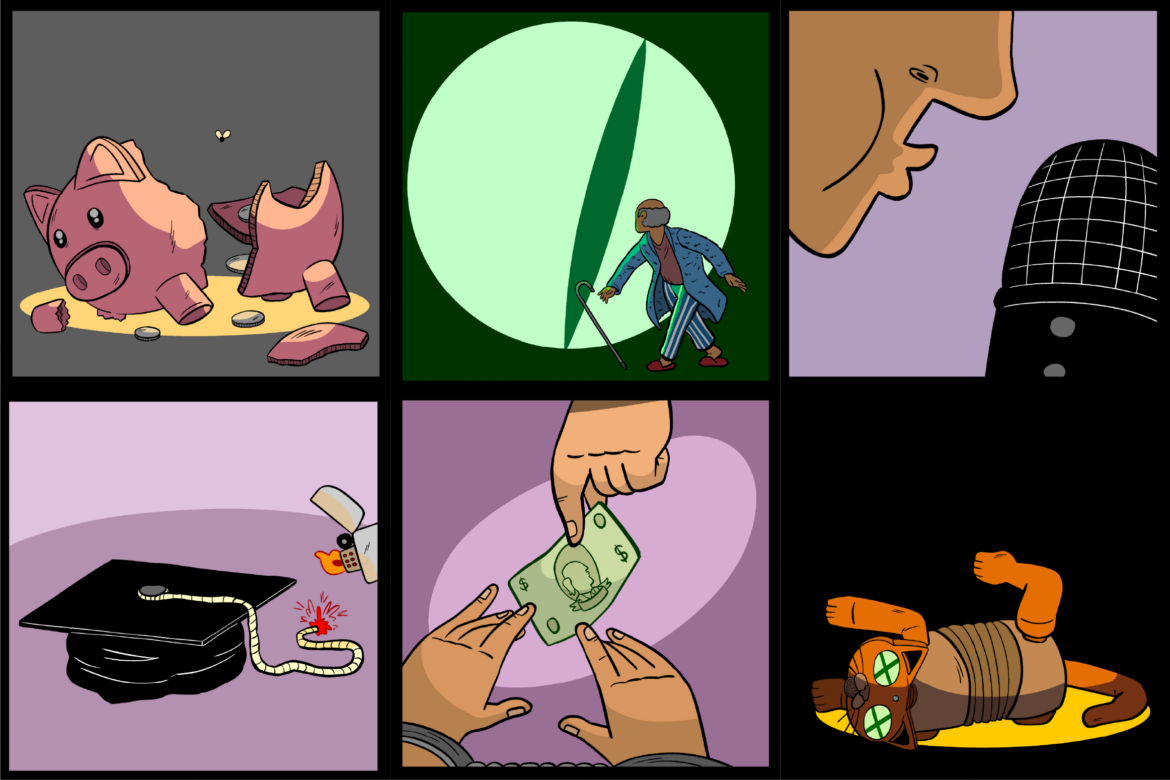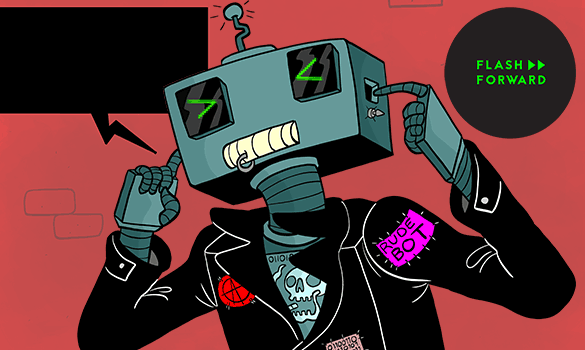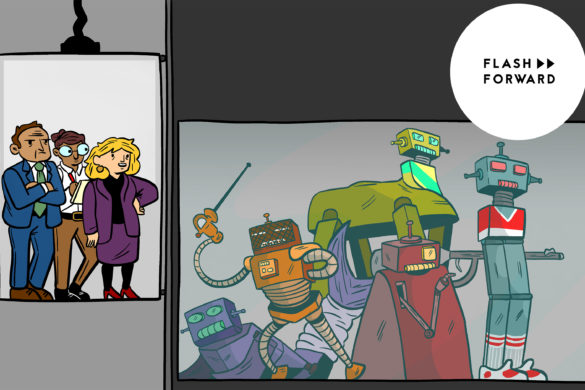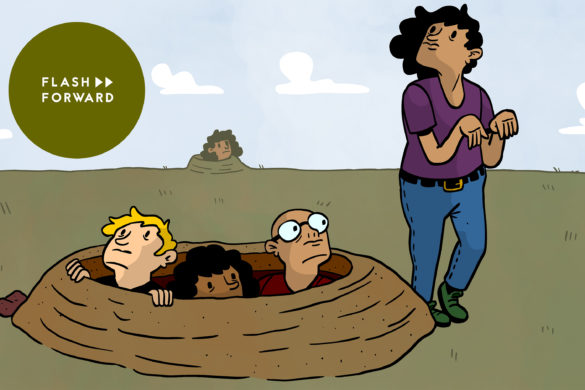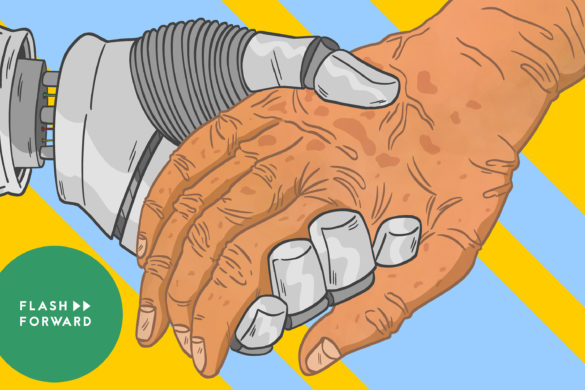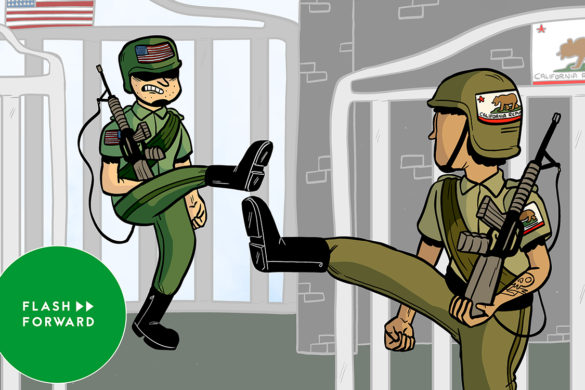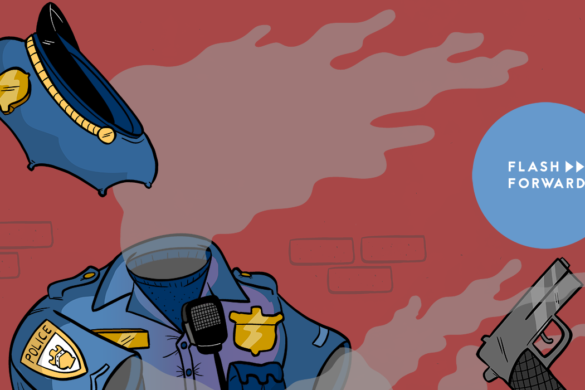In this series, we’re taking a look at some of the real science, policy, economics, law and ethics that inspired the events of Vanguard Estates. Today we’re digging into the economics of senior care — both for the families and individuals who need care, and those who provide it.
Guests:
- Laurie Orlov: founder of Aging and Health Technology Watch
- Dyvonne Body: community development specialist for the Federal Reserve Bank of New York, lead author of The True Cost of Caregiving report.
- Nikki: care partner & founder of A Log Cabin in Brooklyn
- Dr. Alana Lee Glaser: assistant professor of anthropology at Saint John’s University
- Kate Swaffer: activist & author, co-founder of Dementia Alliance International
- Dr. Clara Berridge: associate professor at the University of Washington School of Social Work
- Victor Wang: CEO of care.coach
Further Reading:
- The True Cost of Caregiving report
- Increase in Income Inequality Driven by Real Declines in Income at the Bottom
- 6 in 10 Americans don’t have $500 in savings
- Demographic Turning Points for the United States: Population Projections for 2020 to 2060 (PDF)
- From Pyramid to Pillar: A Century of Change, Population of the U.S.
- Women, Caregiving, and COVID-19
- Nearly 2.2 Million Women Have Left the Labor Force Since February (PDF)
- Caregiving and the Sandwich Generation
- Cost of Care Survey
- Does Medicare pay for assisted living?
- AARP Research Shows Family Caregivers Face Significant Financial Strain, Spend on Average $7,242 Each Year
- Racial Disparities in Nursing Home Care
- Estimating the economic burden of racial health inequalities in the United States
- Consumer Directed Personal Assistance Program
- Long Term Care Trust Act
- American Families Plan
- Care workers are deeply undervalued and underpaid
- The New Status of Home Care Workers Under the Fair Labor Standards Act
- The New Deal devalued home care workers. Advocates hope new legislation can undo that.
- Hidden Voices: Enslaved Women in the Lowcountry and U.S. South
- How wage relations evolved after emancipation compelled slave owners to pay the domestic workers they had once enslaved.
- The hidden help : Black domestic workers in the Civil Rights Movement.Movement. (PDF)
- An Explainer: What’s Happening with Domestic Workers’ Rights?
- Domestic Workers United
- New York Domestic Worker Bill of Rights
- An investigation by Reveal from the Center for Investigative Reporting uncovers widespread exploitation of workers who tend to the elderly.
- Elderly often face neglect in California care homes that exploit workers
- Ain’t I A Woman?! Campaign
- Uberized Care: Employment Status, Surveillance, and Technological Erasure in the Home Health Care Sector (PDF)
- Cameras in Nursing Homes: Pros and Cons
- Disability Rights and Labor: Is This Conflict Really Necessary?
- Get the Facts on Elder Abuse
- Ghost Work
- If 1 in 5 healthcare workers have quit, where have they gone?
Episode Sponsors:
- Tavour: Tavour is THE app for fans of beer, craft brews, and trying new and exciting labels. You sign up in the app and can choose the beers you’re interested in (including two new ones DAILY) adding to your own personalized crate. Use code: flashforward for $10 off after your first order of $25 or more.
Flash Forward is hosted by Rose Eveleth and produced by Ozzy Llinas Goodman. The intro music is by Asura and the outro music is by Hussalonia. The episode art is by Mattie Lubchansky. Amanda McLoughlin and Multitude Productions handle our ad sales. This is a companion episode to the Vanguard Estates series, which you can hear in the Flash Forward feed.
That’s all for this future, come back next time and we’ll travel to a new one.
FULL TRANSCRIPT BELOW
(provided by Emily White at The Wordary)
▹▹ ▹▹ ▹▹ ▹▹ ▹▹ ▹▹ ▹▹ ▹▹ ▹▹ ▹▹ ▹▹ ▹▹ ▹▹ ▹▹ ▹▹ ▹▹ ▹▹ ▹▹ ▹▹ ▹▹ ▹▹ ▹▹ ▹▹
FLASH FORWARD
Vanguard Estates: “The True Cost of Care”
[Flash Forward intro music – “Whispering Through” by Asura, an electronic, rhythm-heavy piece]
ROSE EVELETH:
Hello there! Rose here again, and this is our fourth episode exploring the real stuff that inspired the “Welcome to Vanguard Estates” series. Today we’re talking about money. And I’ll say off the bat here that this episode is going to mostly talk about how the economics of care work in the United States, which is not necessarily how it works globally. So yes, international listeners, I know, we’re doing a US-focused episode, I’m sorry. This is how it is. The story that you heard is set in the US, and there’s just no way to cover how this works everywhere.
So with that apology/disclaimer out of the way, let’s talk money. First, we’re going to talk about how expensive it is to get care. Then we’re going to talk about how hard it is to work in the care industry and make a reasonable living; two sides to the same coin.
As part of my research for “Welcome to Vanguard Estates”, I spent a lot of time on Reddit, reading posts from people struggling to help support their loved ones. A lot of the scenarios and conundrums that you heard in the various storylines in those various storylines in “Welcome to Vanguard Estates” came from real situations that I found in these threads. That includes, by the way, the incredibly predatory loan that the father signs up for in one of the storylines.
Last week, you heard all about the various technologies that can be useful for folks as they age. And when I asked Laurie Orlov, our industry analyst, (you heard her on the last episode too) about the barriers that keep people from using tech, she immediately said: money.
LAURIE ORLOV:
Well, one of the challenges, of course, is always cost. So, the wealthiest part of a market can probably afford all of the technologies that I’ve described quite easily. It’s becoming harder and harder for the middle tier of the financial market, for people, to afford many of these technologies. And at the low-income end of the market, it’s difficult to afford any of them.
ROSE:
And this answer was about technology, but it could also be about… pretty much everything when it comes to senior care. Wealthy people can afford it, and everybody else has to kind of scrape around and hope for the best.
DYONNE BODY:
It costs a lot. Just… period.
ROSE:
This is Dyvonne Body. She’s a community development specialist for the Federal Reserve Bank of New York, and in order to be able to talk with us today she had to offer this disclaimer:
DYVONNE:
My opinions are my own and they do not represent the Federal Reserve Bank of New York or the Federal Reserve System.
ROSE:
At her last job, at the Aspen Institute Financial Security Program, Dyvonne wrote a report called “The True Cost of Caregiving”.
DYVONNE:
So every year or so we do an expert survey that basically asks, you know, what are the financial issues that are most important to families, to people, to human beings? Or another way that we usually put it is: What is the issue that keeps you up at night? And in 2019, we did this survey, and for the first time, one of the top three answers was caregiving.
ROSE:
The report looks at three kinds of care: child care, adult care, and elder care. We are obviously going to focus on that last one, elder care, but it is not always easy to tease apart the three, for reasons we’ll talk about in a minute.
So before we get into this, let’s set the stage with a couple of numbers. According to the US Census Bureau, by 2030 there will be 1 billion people on this Earth who are over 65. In the United States, there are currently about 50 million people in that age group, 65 and older. You’ve probably heard about this, right? That there’s a silver tsunami coming; that is my favorite term for it that I’ve read. Instead of our population looking like a pyramid, with more younger people at the bottom, and then dwindling down to fewer older people, it looks more like a diamond, with this bulge in the middle. Eventually, that bulge will find its way to the top and we will have, essentially, an upside-down pyramid, with more older people than younger ones.
DYVONNE:
I was looking at some data earlier, and it basically stated that the number projected, actually… that the number of people in the United States who are age 65 and older is projected to more than double between 2015 and 2060. And then again, for people age 85 and older, the population growth is expected to increase from 6 million to 20 million in 2060. So this is just going to be a very large need in the future.
ROSE:
The implications of this are really wide-reaching culturally and politically. But for our purposes, we are going to focus on the question of caring for that big group of aging folks. Because at some point or another, pretty much all of those people will need care of some kind.
And there are two main types of care that we’re going to talk about.
DYVONNE:
The first being family caregivers. Family caregivers are generally family members who are providing care, whether that is to a child, to a loved one, to their parents who are aging, or someone who needs help within their family.
ROSE:
This is unpaid work; these are family members stepping in and taking this on.
DYVONNE:
There’s more than 50 million people providing unpaid care to a child or an adult. And just to give a clear picture, this is nearly one in five people in the United States.
ROSE:
And there’s one big commonality among these family caregivers.
DYVONNE:
They are mostly women. And as we stated in the report, an estimated six in ten family caregivers are women, or at least were women at the time that this report was written.
ROSE:
The COVID-19 pandemic has really exacerbated this statistic. When schools shut down, and childcare facilities shut down, and many adult care facilities shut down, it was disproportionately women who wound up dropping their careers to care for the family.
DYVONNE:
And actually, a report by the National Women’s Law Center, which did a quick analysis of the Bureau of Labor Statistics at the time, found that over 2 million women left the labor force between February and October 2020. And even more troubling is that women of color typically play the largest role, with Black and Latino women providing caregiving at higher rates than white women.
ROSE:
We saw this happen in our story, right? Our narrator winds up having to make a choice between work, school, and caring for their father. And this is what Nikki did for her mom too.
NIKKI:
I quit my job. I was working in the fashion industry as an account executive for a swimwear company that was expanding into a big clothing line. I had quit so that I could be my mom’s full-time caregiver. So, I was able to lean off of my savings for about 4-6 months, and I did try to do freelancing and part-time jobs in the interim of the 4-6 months, but going outside and working was not sustainable.
DYVONNE:
Having to make the decision between, “I’m going to go work my job and earn a wage,” or “I’m going to stay home,” that’s such a hard decision because, at the end of the day, we all have rents to pay, bills to pay. We all have these different financial responsibilities.
ROSE:
And in many cases, these folks are actually caring for both ends of the family.
DYVONNE:
Of this entire population, about 28% of family caregivers are providing care to both an adult and a child. And this is known as the sandwich generation.
ROSE:
This happens because in the US, care, both for children and for adults and elders, is really expensive.
And that brings us to the second type of care, which Dyvonne calls direct care.
DYVONNE:
And direct care is basically just a realm of care where it provides for older adults and people living with disabilities. This can usually include personal care aides, or home health aides, or nursing assistants.
ROSE:
There are about 5.7 million direct care workers in the United States today. We’re going to come back to those folks, who they are, what that work is like, and what their economic situation is, in a little bit.
But if you want to hire someone like this, or to live in a facility with a staff, or anything like that… It is really expensive.
In 2020, the median annual cost range for non-medical in-home care, so things like helping with cooking and laundry and kind of like the day-to-day stuff, that costs about $60,000 annually. Community and assisted living — so things like shared living quarters with some supervision and medical management, that costs anywhere between $20,000 and $55,000 a year. Then there are nursing homes.
DYVONNE:
Which provides room and board and a higher level of supervision. This is the most expensive. Nursing homes are $90,000 to $102,000. And so, just taking in those costs altogether, it’s kind of staggering. And this is on an annual basis.
ROSE:
I don’t know about you, but I personally don’t have $20,000 every year just, sort of, hanging around. And most people don’t.
DYVONNE:
Even the lowest range of annual cost is more than 30% of median family income in 30 states.
ROSE:
And in a lot of cases, insurance doesn’t cover this stuff. Some people have success getting financial support through Medicare, or Medicaid, or other programs, but not everybody does. It’s also often hard to figure out what even exists in your state or region in terms of financial support.
DYVONNE:
So, what exists currently is really a patchwork of systems that help support family needs. And not to say that what exists right now is bad, but it is very complicated. It really relies on the state that you live in and it relies on the employer that you work for. And unfortunately, because of this, millions of households fall into gaps in our care system. Some people simply can’t afford to pay out of pocket, and some people lack access to government programs that can help them meet rising costs.
ROSE:
In the interviews for the report, Dyvonne says she heard stories of people going into pretty deep credit card debt to pay for care.
DYVONNE:
They delayed major life purchases and they tapped into their emergency savings. And even more troubling, they tapped into their retirement funds.
ROSE:
Then there are those who we talked about earlier, the family caregivers. That’s expensive too.
DYVONNE:
Family caregivers spend an average of $6,900 of their annual income, or about 20%, on out-of-pocket costs related to caregiving.
ROSE:
Not to mention the burnout that we talked about on the first episode, and the fact that these folks now aren’t able to pursue the jobs and careers they had before.
And, like we talked about on the second episode, these impacts are not evenly distributed.
DYVONNE:
People of color were and are more likely to receive lower quality care, and to have lower financial resources to actually afford this care, and then additionally fewer culturally appropriate care options. There was actually a study in 2011 in the International Journal of Health Services that showed that the elimination of health disparities for people of color reduces indirect costs associated with illness and premature death, which is really important.
ROSE:
So what does a better way look like? If we wanted to go big, rethinking our entire medical industrial complex and health system and insurance in the United States would be great. But maybe let’s start a little smaller. There is some low-hanging fruit that could make a difference really quickly.
DYVONNE:
So in the report, what we find that can help build a more just and equitable care system includes having more access to federal and state subsidies. This will mostly help protect families from the high unaffordability of direct care and prevents them from spending down their own savings and going into debt.
ROSE:
In New York State, for example, there’s a program called the Consumer Directed Personal Assistance Program, or CDPAP. This program basically allows for people who are eligible for Medicaid to select, train, and direct their own caregivers. And what that really means is that if you have a family member or friend who actually wants to provide care, you can hire them and get them trained through this program. So instead of having to quit their job and not have an income, they could actually get paid to do this work.
Another thing Dyvonne and her team identified in their report is making it easier to actually qualify for programs like Medicare.
DYVONNE:
So, there are federal and state insurance programs, including Medicaid, Medicare, Social Security, disability insurance, and more. They all should have very flexible eligibility rules that allow more families to be able to access subsidized care.
ROSE:
This is something that Washington State is trying to do now. In 2019, they passed the Long Term Care Trust Act.
DYVONNE:
And the bill provided a lifetime benefit of up to $36,500 for people who need assistance with activities of daily living.
ROSE:
And the eligibility for that benefit is far more flexible than in a lot of other places.
DYVONNE:
The true benefits of this Long Term Care Trust Act in Washington is that it gives families another option when they are unable to access Medicaid, Medicare, and the existing disability supports that really help people fund the long-term care needs that people will have.
ROSE:
This kind of thing was actually part of the American Families Plan put forth by President Joe Biden.
DYVONNE:
The American Families Plan really has some important care infrastructure essentials, one of them being about $400 billion dedicated to expand access to quality and affordable home or community-based care for aging relatives and people with disabilities. So, a provision like that would be really, really life-changing for a lot of families just by improving access in the first place.
ROSE:
As you perhaps know, that plan did not make the cut in Congress. So for now, Americans are going to continue to struggle to figure out how to pay for the care that we are all going to need at some point. And that was Dyvonne’s big takeaway, that this isn’t a niche thing; this isn’t something that we can just, kind of, ignore.
DYVONNE:
Everyone will need care at some point in their lives. From infants, to adults, to elders, care is a universal need. It’s the backbone of our economy. The sooner we realize that this is a universal need, I think the more will be done to build a more equitable care infrastructure.
ROSE:
As it stands, it’s really, really hard to find and pay for quality senior care. And it doesn’t seem like it’s going to get any easier. And I think the failure of Joe Biden’s American Families Plan actually highlights one of the reasons why. When you look at the arguments made online against that bill, against spending that money, it often boils down to the idea that care work isn’t “real” work.
And that is an insidious belief that I think many people don’t even realize, perhaps, that they have. This idea that, “Well, of course you wouldn’t pay people to care for their family, that’s just… what you do! That’s not real work!” But that idea is not only rooted in some dark history, it’s also one that creates seriously bad working conditions for both family caregivers and professional ones.
When we come back we are going to talk about the employee side of this coin, and what it’s like to actually try to make a living providing care in this country. But first, a quick break.
ADVERTISEMENT: SPONSOR
This ad talks about alcohol. If you don’t want to hear that, skip it.
Lots of people found themselves pandemic hobbies. Plants, knitting, roller skating. And some people I know got really into beer. And if you did, or you were already into beer, or you’re just, like, beer curious, Tavour has a beer for you. Or, honestly, probably many beers.
Tavour is an incredible place to find craft beer from all over the US. Tavour does all the searching for you, giving you easy access to a wide range of craft brews from across state lines. All you have to do is download the Tavour app to get access to hard-to-find, 100% independent craft beer from all across the country. Build your own custom box of the craft beers you love, or enroll in a beer subscription, and they will automatically snag the highest-rated beers that suit your taste. No minimums or commitments.
Get your hand-picked beer delivered right to your doorstep for a flat fee, or ship for free with a subscription. Taste the extra care brewers put into every IPA, stout, and sour ale. Explore tried-and-true classic beer styles and trendsetting hybrids from some of the country’s best breweries. Essentially, you get a VIP invite into the craft beer community. Discover outstanding beers, support indie breweries, and flaunt your beer haul a little bit too.
Download the app from the app store to try Tavour now and use “flashfoward” for $10 off your first order of $25 or more.
ADVERTISEMENT END
ROSE:
Okay, so it is hard to get care in the United States. But it’s also hard to give care. The people working in direct care — working as home health aides or nursing home employees — are often underpaid, overworked, and just straight-up exploited.
DYVONNE:
I think the most shocking thing is care workers are among the lowest paid in our nation. They do not earn a living wage. And if you look into data, home care workers earn a median of $14 per hour, which is right around $29,000 per year. So in addition to being some of the lowest-paid workers in our nation, care workers also experience very inconsistent work hours, marginal labor protections, and from what we hear, limited opportunities for career growth, and just in general, long-term mobility.
ROSE:
Not only are these workers paid incredibly low wages, they are also often excluded from workplace protections.
DYVONNE:
There’s just such a vast history of gender and race that plays into the dynamics of why domestic workers maybe are left out of very simple rights that are granted to a lot of workers today.
ROSE:
And it will perhaps not surprise you that that history has a whole lot to do with both sexism and racism.
DYVONNE:
So women of color in particular, they provided childcare and domestic work since, you know, the 1600s, with many Black women being forced to care for the children of their enslavers.
ROSE:
That laid the foundation for the idea that this work was not worth paying for. During the Civil War, nursing emerged as a job that mostly women did — and for the Confederacy, that actually included enslaved women. When slavery was abolished, women were expected to step into the roles that enslaved people were doing that included care work. Often, these were the very same women who had done this work under slavery, forced into unethical employment contracts with wealthy white landowners.
Since the Civil War, women have clawed their way into the paid workforce despite endless efforts, both overt and more subtle, to keep them out. And the fields that were a little easier to get into as a woman tended to be these caregiving professions.
DYVONNE:
So women were, in the past and continue to be, very prominent in caregiving roles, whether that was family caregiving or professional caregiving. A lot of these roles involve childcare, nursing, domestic work.
ROSE:
But that insidious history, the one that built care work on a foundation of enslavement, has meant that, even now, care workers don’t get the same kinds of protections and pay as other industries that don’t have that same history. In 1935 the US passed something called the National Labor Relations Act, and then three years later, a similar law called the Fair Labor Standards Act.
ALANA LEE GLASER:
That protects workers from harassment, from overtime withholding, from unfair hiring and firing practices.
ROSE:
That’s Dr. Alana Lee Glaser, an Assistant Professor of Anthropology at Saint John’s University. These two laws were, in theory, great for workers. Except that they said that the protections they outline do not apply to domestic workers.
ALANA:
Because it takes place in the home, and because there are all these impressions about who does it, and whether or not it constitutes real work, that kind of thing.
ROSE:
One of the key demands of the Civil Rights movement in the 1960s was for labor protections to be extended to these kinds of jobs that were largely done by Black workers. In the 1970s, activists had some success at getting these laws amended, but there are still places where the labor protection laws exclude care work. That’s actually how Alana got interested in this topic.
ALANA:
I had come out of some labor union organizing and was interested in those questions, but also had a strong, kind of, feminist bent and really wanted to ask questions about where working women were fighting for improved wages, better conditions on the job, better, maybe, political recognition. And I came to this organization in New York called Domestic Workers United that is an activist organization representing home healthcare workers, childcare providers, and house cleaners throughout New York. And for about ten years, they lobbied the New York state legislature to pass a series of laws that are codified as the New York Domestic Worker Bill of Rights.
ROSE:
Over half of the people who work as home health aides in the United States are women of color. And nearly 40% of them were born outside the United States.
And many of these workers are employed by private companies and classified as independent contractors. Which means they don’t get health insurance or other benefits. These companies don’t actually have much overhead, they basically just have a computer and a Rolodex of workers.
ALANA:
And they typically charge something like two times the rate of what they pay to the people who work for them. So they might charge you or I $20 an hour to care for our loved ones. And then the person actually doing the work might see $10 or $8 an hour of that amount, even though, again, there isn’t overhead enough to account for that gap.
ROSE:
And in some cases, the workers actually have to pay the company for their placement.
ALANA:
And the way that it works, in many cases though not all, is that the job seeker themselves pays a small portion of their first week’s pay to the placement agency. So the income-generating component of the job placements agency actually is on the backs of the workers.
ROSE:
Often, these firms don’t seem to really care if their workers are treated well.
ALANA:
And that also extends to incidences where the home health care workers report, you know, being mistreated, not being able to access food on the job, not being able to find a safe and comfortable place to sleep, being berated, being locked in the homes where they, you know, spend sometimes one, sometimes two, sometimes three weeks working 24 hours a day.
ROSE:
The Ain’t I A Woman?! campaign, which is a group of workers who organize for the rights of laborers, including home health aides in New York City, has a series of testimonials on their site about the ways that these companies exploit their employees.
One care worker, Rui Ling Wang, says that, “Long-term 24-hour care work made me anxious, nervous, sleep-deprived, with aching limbs and waist, high blood pressure, and stomach disease. You could say that I too become a ‘patient.’” Another worker, Hui Ling Chen, said that the company that she worked for, “told home attendants ‘do not give water to patients at night, do not get up from bed to change their diapers, ignore the patient when they call for help.’” Right now, Ain’t I A Woman?! is organizing to try and end 24-hour care shifts in New York City, which often wind up stretching to as long as 72 hours for these workers, without any breaks.
Alana says that, in her research, she found that some of these employers treated their workers essentially as disposable.
ALANA:
This agency in particular and others like it particularly preyed upon people who had relatively recently immigrated to New York and had few other options because they were waiting for paperwork to go through or were waiting for official documentation that might make working elsewhere more feasible.
ROSE:
And since the firm is getting a kickback with every new placement, it makes sense that they don’t mind cycling through workers at this rate.
These firms illustrate something that Alana has called the Uberization of Senior Care. This idea has two parts. The first is what we just talked about — all these industries, senior care included, are trying to save costs by misclassifying workers as independent contractors. The apps or companies control access to these workers, and take a cut, but they don’t offer their workers any kind of protections or benefits.
The second piece of the Uberization of an industry is surveillance. We talked last week about the ways that facilities will install cameras without really talking to patients. But it’s worth noting that, often, facilities are installing cameras without talking to their workers either. And in many cases, these cameras are there to watch employees as much as they are to watch patients.
ALANA:
There are these real-time locating systems where nurses’ movements are literally tracked throughout, like, an acute care hospital or long-term living facility.
ROSE:
In the past, workers would be required to call and clock in using a patient’s home phone. Now, there are apps that track them through their entire visit and cameras that watch them while they’re in the room.
Technologies that track direct care employees are often justified in two ways. The first is by arguing for efficiency — saying that we need to maximize every single second of time that a worker has, and we can do that by tracking their every move. If you’ve listened to this show at all you probably know how I feel about that argument, which is in part that there is often very little evidence that tracking people actually leads to increased efficiency. And in the case of care in particular, perhaps shooting for maximum efficiency should not be the goal?
ALANA:
There ends up being a kind of objectification of the elderly people in their care’s bodies because they’re, sort of, moving through these processes as quickly as they possibly can. And then that leaves the emotional, relational, cognitive needs of elderly patients unattended to because it’s simply infeasible.
ROSE:
The second reason you see people arguing for tracking workers is the idea that employees need to be tracked because of course they are going to do a bad job if they are not.
ALANA:
The surveillance, and the tracking, and the reporting of work tasks, of work hours, tends to have a strong, kind of, surveillance component that assumes the people who do these jobs are going to clock out early, or are going to fail to complete important tasks that the patients in their care rely on them for, or that they will take advantage of the system.
ROSE:
Alana knows this firsthand because, for a few years, she actually worked for an elder care company herself. And she says that that experience helped her know what to ask when interviewing fellow workers.
ALANA:
I knew that, you know, for example, I haven’t gone a day without being struck by the woman that I take care of. She hits me every time she sees me. So I was, you know, all of a sudden asking people who did care work in the home, “Have you ever been struck? Have you ever been pinched, have ever been bitten?”
ROSE:
Now, for a long time I think that there has been kind of an antagonistic relationship between disability activists who might reside in some of these places, and the worker activists representing these workers. So, for example, when I spoke with Kate Swaffer about cameras, her first reaction was that they could be useful to catch cases of abuse in nursing homes perpetuated by the staff.
KATE SWAFFER:
If I was the family member or legal guardian… Well, I have been, obviously. I said that earlier, that I’ve been one for three people. I wished I had surveillance cameras in their rooms. You know, we’ve got footage in Australia of a care worker smothering someone’s face with pillows.
ROSE:
This does happen, and it’s terrible, and should absolutely not happen, and catching these people is worth trying to do. We’re going to talk more about the conditions in nursing homes next week. But it’s also worth noting that cases of direct abuse like this, at the hands of care workers, are maybe not as common as we might think.
CLARA BERRIDGE:
Elder abuse is way underreported. I think that people often imagine, when they think of elder abuse, horrendous physical and sexual abuse in nursing homes by staff, right? And that’s a huge problem. But especially when we’re studying surveillance technology, the reality of abuse among older adults is that it’s far more common at the hands of family, of spouses and adult children, than it is by personal aides or workers.
ROSE:
That’s Dr. Clara Berridge again, the social work professor who studies aging and technology.
ALANA:
And so there’s a kind of presumption that the women who do this work might cut corners or might not provide an adequate level of care, even though there’s almost no evidence of widespread patterns of that kind of neglect or time theft. And there is very little evidence of widespread instances of abuse, you know, for example.
ROSE:
I think the key thing that I want to say here, is that this doesn’t have to be an either/or situation. These two groups actually have way more in common than they do that separates them. Both groups are suffering while the people who run these institutions and companies are making money.
The baseline assumption that workers must be surveilled in order to not be abusive or neglectful, it doesn’t exactly make for a great work environment. I mean, imagine if you got to work and your boss was like, “Okay, so my assumption is that you are a terrible person and a terrible worker who will probably abuse or neglect your post and so I’m going to watch every single thing you do so that I can catch you.” That doesn’t really… make you want to put your heart and soul into a job, does it?
We talked last week about the ways in which constant surveillance can impact a patient. But it also impacts the care they receive and the working conditions.
CLARA:
When a technology, like a camera, for example, in a nursing home resident room is used pretty clearly to surveil the worker, it can send a message that they’re not trusted to provide for the patient’s best interests. And then the ethical concern is that could erode… One of the ethical concerns is that could erode their sense of being the trusted, responsible care provider.
ROSE:
Another thing that nursing homes or care facilities will do to save money, is to employ only a small number of people who are adequately trained in the job, and then it’s up to families and residents to employ additional people who have less training to fill the gaps. Alana says that she experienced this herself. She was hired, essentially, to provide social care for a woman. Conversations, hanging out with her, keeping her cognitively stimulated.
ALANA:
And so I wasn’t, like, clued into or trained in how to also address some of the physical aspects of her condition that were present. And they were present throughout the time I spent with her, and because of the very, very narrow scope that my role entailed, because of this kind of process of having… like, essentially I was paid to fill in one little hole in what would have previously been a much more integrated care work position. It ended up meaning that the times that she was with me, she was not getting adequate physical care because I hadn’t been trained to do it or expected to do it. And I was particularly struck by the fact that no one except for other workers on the floor, mentioned to me what her physical needs were.
ROSE:
Technology comes into play here too. In some places, there is one nurse on call watching a wall of screens with feeds into people’s rooms, responding only if there is an emergency.
ALANA:
Actually, the way that Kaiser Permanente does it, they have nurses observing these, like, closed-circuit television monitors from another state. And then they call the floor nurse and say, “Hey, did you know that room 302 needs help getting to the bathroom?” or whatever it is. And there’s this, like, related problem where there’s constantly buzzers and alarms going off because the patients are so heavily surveilled in both long-term living and acute care facilities, and so they, like, just start tuning out these alarms because they’re so frequently going off in error.
And so it’s, like, that overstimulation problem where you’re just becoming accustomed to having all of your patients alarms buzzing at once, and then you actually go to check on it and nothing has happened. So, there’s a real desensitization to these bells and whistles that all of the surveillance technology give off to, like, alert someone to come help.
ROSE:
All of this reduces both the workers and the older people in these situations to, sort of, cogs in a machine, to things that need to be maximally efficient, constantly surveilled, constantly scrutinized.
And it matters that these workers are treated fairly. I mean, just because at the baseline everyone should be paid fairly and treated well at work. But also because if workers are underpaid, miserable, and being exploited, their work isn’t going to be very good.
ALANA:
The health of patients is so intricately connected to the working conditions of caregivers, whether it’s nurses or doctors. Increasingly, doctors are subject to the same kind of capitalist efficiency policies that nurses, and home health care, and elder care providers have long been subject to.
ROSE:
What that means is that every interaction becomes a business transaction, rather than an act of care. Alana told a story about the woman she was caring for, and a situation in which she needed a diaper change.
ALANA:
She did not want a diaper change. And that’s such a private, and personal, and an invasive experience.
ROSE:
In this moment, as a care provider, you’ve got to wade into some murky ethical waters right? On the one hand, you want to respect this person’s autonomy. On the other hand, there are risks to letting someone spend too much time in a soiled diaper. At the time, Alana was able to ask for help from the certified nursing assistant on staff and they worked it out. But in a future where these places keep shifting further and further towards efficiency and surveillance, that negotiation looks really different.
ALANA:
My prediction is that the cost-saving imperatives, that kind of emphasis on efficiency, that the understaffing, the pruning of workers’ repertoire of duties and tasks worsens those kinds of conflicts because it’s just… there’s so much more pressure to get things done quickly so that you don’t have time for, like, more nuanced coaxing and discussion or more kind of flexible negotiation of like, “Okay, now is not the time to change that diaper. I can come back, you know, or I can get someone else who you’re more comfortable with.”
ROSE:
Earlier in this episode, we talked about the demographic trends in aging and about how, in the next few decades, there will be a huge increase in people who need care. Meanwhile, the actual number of people who work in the direct care industry is decreasing. And it’s not really hard to understand why, right? We just talked about how this industry pays really poorly and often includes exploitative workplace conditions.
One solution that people raise is outsourcing. Which brings us back to Missy from last episode. Care.coach health advocates are not based in the United States.
VICTOR:
And we hire them in the Philippines and Latin American countries for Spanish.
ROSE:
Victor likes to brag about the rigorous hiring process these workers go through.
VICTOR:
Yeah, a lot of it is our secret sauce, because as far as I know, we’re the only company in the world that actually does exactly this. But the overall of it is that it’s quite a sophisticated process. We end up hiring 1% of our applicants. So it’s like, easier to get into, like, UC Berkeley, or Stanford, or something like that.
ROSE:
Potential workers go through a bunch of steps and screenings and trainings. And here’s what he said when I asked how much a Care.coach employee gets paid.
VICTOR:
I will compare it to what a registered nurse who got a bachelor’s degree in nursing would make if they commuted a couple of hours a day to a local hospital in the Philippines and worked a grueling 12-hour shift. That’s what they make.
ROSE:
According to Indeed.com, the average salary for a nurse in the Philippines is 21,000 pesos a month, which is about $370. Which comes out to an annual salary of about $5,000.
VICTOR:
Which ends up being very cost effective here in the US.
ROSE:
If you are part of the Flash Forward book club, you might remember that we read a book called Ghost Work, all about remote, largely international workers and the power dynamics at play in those kinds of jobs, which is complicated and fraught.
But there are things that these remote workers can’t do, right? Lots of people, millions of people, need in-person care. And across the US people are finding that there simply are not workers taking those jobs. People who used to be employed by these elder care firms are deciding to move on — often, if they can, transitioning to better-paying healthcare jobs, but sometimes leaving care work entirely.
And again, this is only going to get worse.
Unless we do something. And there are things to do. Both culturally changing how we think about senior care, and politically demanding that these workers and programs get the funding and pay they deserve.
In general, I think we tend to shove the idea of aging off into its own little box. But this is really all about care. Caring for one another in all kinds of stages of life. And if we re-evaluate how we think about care, who does it, and what it’s worth, we can start to imagine a better future of aging.
ALANA:
My, kind of, real big pie-in-the-sky kind of romantic vision of these things is that, you know, were it possible to have a society organized around caring for one another, caring for ourselves, rather than sort of spending every waking moment selling our labor power so that we can afford to eat and have a home, that there would be like ample, easy resources for a, kind of, seamless aging process or seamless process of illness and wellness that didn’t have to be isolating or alienated, and that didn’t result in that kind of fracturing of our sense of our physical needs from our emotional or cognitive needs.
ROSE:
Next week we’re going to try and sum all of this up. What does it look like to age in the future? Where do you want to grow old? Why is there still such a big gap between what people want and what people get? And what can be done about it?
[Flash Forward closing music begins – a snapping, synthy piece]
That’s all for this episode. Flash Forward is hosted by me, Rose Eveleth, and produced by Ozzy Llinas Goodman. The intro music is by Asura and the outro music is by Hussalonia. The episode art is by Mattie Lubchansky.
Come back next week for our final episode in this series about the real stories and research that inspired Welcome to Vanguard Estates.
Until then!
[music fades out]

